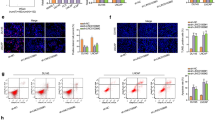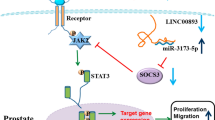Abstract
In prior research, evidence has been found for a relation between low exposure of long non-coding RNAs (lncRNAs) and prostate tumor genesis. This study aims to clarify the underlying mechanisms of lncRNA GAS5 in prostate cancer (PCa). In total, 118 pairs of PCa tissues and matched adjacent non-tumor tissues were collected. Additionally, lncRNA GAS5 exposure levels were determined using RT-PCR and in situ hybridization. In addition, dual-luciferase report assay was performed to verify the target effect of lncRNA GAS5 on miR-103. The exposure levels of the proteins related to the protein kinase B (AKT)/mammalian target of rapamycin (mTOR) axis, including AKT, mTOR, and S6K1, were measured by western blot PC3 cells infected with lncRNA GAS5 mimic; lncRNA GAS5 siRNA; or a combination of lncRNA and miR-103. The proliferation, invasion, and migration ability of PC3 cells after being infected were tested by MTT assay, wound healing assay, and transwell assays. Finally, nude mouse xenograft models were used to measure lncRNA GAS5 effects on prostate tumor growth in vivo. The lncRNA GAS5 levels were reduced significantly in the PCa tissues and cell lines (P < 0.05). A low exposure of lncRNA GAS5 caused AKT/mTOR signaling pathway activation in PC3 cells (P < 0.05). In addition, over-exposure of lncRNA GAS5 was proven to significantly decelerate PCa cell progression in vitro and tumor growth in vivo through inactivating the AKT/mTOR signaling pathway (P < 0.05). This study proves that lncRNA GAS5 plays a significant role in the decelerating PCa development via mediating the AKT/mTOR signaling pathway through targeting miR-103.





Similar content being viewed by others
Change history
31 July 2023
This article has been retracted. Please see the Retraction Notice for more detail: https://doi.org/10.3233/TUB-239007
References
Siegel RL, Miller KD, Jemal A. Cancer statistics, 2015. CA Cancer J Clin. 2015;65:5–29.
DeSantis CE, Lin CC, Mariotto AB, et al. Cancer treatment and survivorship statistics, 2014. CA Cancer J Clin. 2014;64:252–71.
Jilg CA, Ketscher A, Metzger E, et al. PRK1/PKN1 controls migration and metastasis of androgen-independent prostate cancer cells. Oncotarget. 2014;5:12646–64.
Bubendorf L, Schopfer A, Wagner U, et al. Metastatic patterns of prostate cancer: an autopsy study of 1,589 patients. Hum Pathol. 2000;31:578–83.
Shi X, Sun M, Liu H, et al. Long non-coding RNAs: a new frontier in the study of human diseases. Cancer Lett. 2013;339:159–66.
Yuan J, Yue H, Zhang M, et al. Transcriptional profiling analysis and functional prediction of long noncoding RNAs in cancer. Oncotarget. 2016;7:8131–42.
Smith CM, Steitz JA. Classification of gas5 as a multi-small-nucleolar-RNA (snoRNA) host gene and a member of the 5′-terminal oligopyrimidine gene family reveals common features of snoRNA host genes. Mol Cell Biol. 1998;18:6897–909.
Schneider C, King RM, Philipson L. Genes specifically expressed at growth arrest of mammalian cells. Cell. 1988;54:787–93.
Sun M, Jin FY, Xia R, et al. Decreased expression of long noncoding RNA gas5 indicates a poor prognosis and promotes cell proliferation in gastric cancer. BMC Cancer. 2014;14:319.
Cao S, Liu W, Li F, et al. Decreased expression of lncRNA gas5 predicts a poor prognosis in cervical cancer. International journal of clinical and experimental pathology. 2014;7:6776–83.
Mourtada-Maarabouni M, Pickard MR, Hedge VL, et al. Gas5, a non-protein-coding RNA, controls apoptosis and is downregulated in breast cancer. Oncogene. 2009;28:195–208.
Pickard MR, Mourtada-Maarabouni M, Williams GT. Long non-coding RNA gas5 regulates apoptosis in prostate cancer cell lines. Biochim Biophys Acta. 2013;1832:1613–23.
Pickard MR, Williams GT. Molecular and cellular mechanisms of action of tumour suppressor gas5 lncRNA. Genes. 2015;6:484–99.
Zhao X, Wang P, Liu J, et al. Gas5 exerts tumor-suppressive functions in human glioma cells by targeting miR-222. Molecular therapy : the journal of the American Society of Gene Therapy. 2015;23:1899–911.
Zhang Z, Zhu Z, Watabe K, et al. Negative regulation of lncRNA gas5 by miR-21. Cell Death Differ. 2013;20:1558–68.
Hay N. The Akt-mTOR tango and its relevance to cancer. Cancer Cell. 2005;8:179–83.
Yacqub-Usman K, Pickard MR, Williams GT. Reciprocal regulation of gas5 lncRNA levels and mTOR inhibitor action in prostate cancer cells. Prostate. 2015;75:693–705.
Landgraf P, Rusu M, Sheridan R, et al. A mammalian microRNA expression atlas based on small RNA library sequencing. Cell. 2007;129:1401–14.
Martello G, Rosato A, Ferrari F, et al. A microRNA targeting dicer for metastasis control. Cell. 2010;141:1195–207.
Nonaka R, Miyake Y, Hata T, et al. Circulating miR-103 and miR-720 as novel serum biomarkers for patients with colorectal cancer. Int J Oncol. 2015;47:1097–102.
Yu D, Zhou H, Xun Q, et al. MicroRNA-103 regulates the growth and invasion of endometrial cancer cells through the downregulation of tissue inhibitor of metalloproteinase 3. Oncol Lett. 2012;3:1221–6.
Li M, Liu Z, Zhang Z, et al. Mir-103 promotes 3t3-l1 cell adipogenesis through AKT/mTOR signal pathway with its target being MEF2D. Biol Chem. 2015;396:235–44.
Gutschner T, Diederichs S. The hallmarks of cancer: a long non-coding RNA point of view. RNA Biol. 2012;9:703–19.
Luo G, Wang M, Wu X, et al. Long non-coding RNA MEG3 inhibits cell proliferation and induces apoptosis in prostate cancer. Cellular physiology and biochemistry : international journal of experimental cellular physiology, biochemistry, and pharmacology. 2015;37:2209–20.
Prensner JR, Chen W, Han S, et al. The long non-coding RNA PCAT-1 promotes prostate cancer cell proliferation through cMyc. Neoplasia. 2014;16:900–8.
Liu Y, Zhao J, Zhang W, et al. LncRNA GAS5 enhances G1 cell cycle arrest via binding to YBX1 to regulate p21 expression in stomach cancer. Scientific reports. 2015;5:10159.
Chang L, Li C, Lan T, et al. Decreased expression of long non-coding RNA GAS5 indicates a poor prognosis and promotes cell proliferation and invasion in hepatocellular carcinoma by regulating vimentin. Mol Med Rep. 2016;13:1541–50.
Liu Z, Wang W, Jiang J, et al. Downregulation of GAS5 promotes bladder cancer cell proliferation, partly by regulating CDK6. PLoS One. 2013;8:e73991.
Shain SA. Exogenous fibroblast growth factors maintain viability, promote proliferation, and suppress GADD45alpha and GAS6 transcript content of prostate cancer cells genetically modified to lack endogenous FGF-2. Molecular cancer research : MCR. 2004;2:653–61.
Romanuik TL, Wang G, Morozova O, et al. LNCaP atlas: gene expression associated with in vivo progression to castration-recurrent prostate cancer. BMC Med Genet. 2010;3:43.
Yu F, Zheng J, Mao Y, et al. Long non-coding RNA growth arrest-specific transcript 5 (GAS5) inhibits liver fibrogenesis through a mechanism of competing endogenous RNA. J Biol Chem. 2015;290:28286–98.
Pei J, Wang B. Notch-1 promotes breast cancer cells proliferation by regulating lncRNA GAS5. Int J Clin Exp Med. 2015;8:14464–71.
Xia W, Ni J, Zhuang J, et al. Mir-103 regulates hepatocellular carcinoma growth by targeting AKAP12. Int J Biochem Cell Biol. 2016;71:1–11.
Barrett D, Brown VI, Grupp SA, et al. Targeting the PI3K/AKT/mTOR signaling axis in children with hematologic malignancies. Paediatric drugs. 2012;14:299–316.
Hay N, Sonenberg N. Upstream and downstream of mTOR. Genes Dev. 2004;18:1926–45.
Ma XM, Blenis J. Molecular mechanisms of mTOR-mediated translational control. Nat Rev Mol Cell Biol. 2009;10:307–18.
Pickard MR, Williams GT. Regulation of apoptosis by long non-coding RNA GAS5 in breast cancer cells: implications for chemotherapy. Breast Cancer Res Treat. 2014;145:359–70.
Taylor BS, Schultz N, Hieronymus H, et al. Integrative genomic profiling of human prostate cancer. Cancer Cell. 2010;18:11–22.
Song W, Wang K, Zhang RJ, et al. Long noncoding RNA GAS5 can predict metastasis and poor prognosis: a meta-analysis. Minerva Med. 2016;107:70–6.
Qiao HP, Gao WS, Huo JX, et al. Long non-coding RNA GAS5 functions as a tumor suppressor in renal cell carcinoma. Asian Pacific journal of cancer prevention : APJCP. 2013;14:1077–82.
Acknowledgments
This work was supported by Changzhou Municipal Science and Technology Bureau Support Project (CE20135046) and Jiangsu Provincial Health Department General Research Project (H201348).
Author information
Authors and Affiliations
Corresponding author
Ethics declarations
The Animal Ethics Committee of Fudan University approved all protocols of animal experiments.
Conflicts of interest
None
Additional information
This article has been retracted. Please see the retraction notice for more detail: https://doi.org/10.3233/TUB-239007"
About this article
Cite this article
Xue, D., Zhou, C., Lu, H. et al. RETRACTED ARTICLE: LncRNA GAS5 inhibits proliferation and progression of prostate cancer by targeting miR-103 through AKT/mTOR signaling pathway. Tumor Biol. 37, 16187–16197 (2016). https://doi.org/10.1007/s13277-016-5429-8
Received:
Accepted:
Published:
Issue Date:
DOI: https://doi.org/10.1007/s13277-016-5429-8




